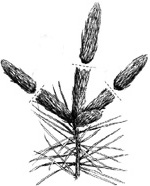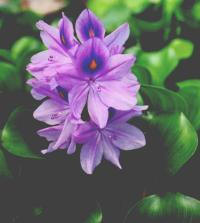Green Thumb Tips - May
-
Echter’s Plant Doctors are available
during store hours seven days a week to answer
your gardening questions. For accurate diagnosis, it helps to bring in a sample. - Flower Gardens
- Wait until danger of frost has passed before planting tender plants. Frost blankets can help protect your plants from unexpected late freezes.
-
- Pinch back your annuals at planting to promote stronger, bushier plants and more flower production.
More on Planting and Caring for Annuals and Vegetables
- Annuals, vegetable plants and roses, selected from inside our greenhouses should be “hardened off” before planting outdoors. This is done by exposing the plants to the hot sun and drying winds gradually until the plants are fully acclimated.
- Use weed preventer to keep weeds from sprouting
in your flower and vegetable gardens after you have
set out your plants. Don't use weed preventer where you are sowing seed until after it is up and growing. - Summer-blooming bulbs like dahlias, gladioli, cannas and lilies can be planted outside now. If you started these bulbs inside and they are now up and
growing, keep your frost blanket handy to cover them if there
is a hard freeze predicted.
Container Gardens- Plant your hanging baskets and container gardens now to give them a good head start. By June they should be well established. Keep an eye on the weather and bring your baskets and containers inside if the weather gets cold.
- If your outdoor hanging baskets and planters have dried out too quickly in the past, mix granules of Soil Moist (a polymer) into the media of your container gardens and hanging baskets before you plant. This will help retain water for the plants to use as needed. We've added polymers to Echter’s Container Mix so you can reduce the frequency of watering.
-
Perennials & Roses - Prune back hybrid tea roses, floribundas and other everblooming roses to 10"
in early May. Also, prune out any dead, diseased or weak
canes.
- Do not do a heavy pruning on climbing roses. Prune only those canes which are broken or dead.
-
Deadhead, (cut off the old flowers) on
daffodils, tulips, hyacinths and other spring-blooming bulbs, but
don't remove foliage until after it turns yellow. The foliage is making nutrients for the bulbs for next year's show of color. -
Weeds
take nutrients from the soil and away from your desirable plants. The
smaller the weed, the easier
it is to remove. Pulling them early will keep them from producing and spreading seeds.
Put up plant supports now for perennials that need to be staked, like delphiniums, peonies, yarrow, etc. Before you know it these plants will be too tall to do it easily. - Speed up the warming of the soil in your perennial and bulb beds by removing the mulch from around the plants.
- Vegetable Gardens
- Make your list of the tomato varieties and pepper varieties you want to grow in your garden from these links. It's easier if you know what you want before you go shopping.
- Plan your vegetable garden so that specific plants, like tomatoes, peppers, squash, cucumbers, etc. are planted in a different spot than they were planted last year. Rotation of your crops is very important to prevent any diseases prone to that particular vegetable.
- When planning your vegetable gardens, consider planting extra rows and
donating the surplus to your
local food bank. - Plant your corn when the soil temperature reaches 60 degrees. Plant in
blocks to improve pollination by
the wind. -
Ross netting over your strawberries will help
keep birds and squirrels out of your fruit crops. In addition,
Bird Scare tape will be beneficial in protecting your fruit.
Check the "When is it safe..." link mentioned above to our Frost Hardiness Chart which will enable you to judge when to plant your vegetable starts. - For anything that you plant outside early this month, make sure that you have a frost blanket handy for those sudden and unexpected cold snaps.
-
For fun
try cherry
tomatoes or strawberries in a hanging basket. Combine tomatoes with lettuce in a
basket for color contrast in an edible combination. - Cedar barrels or large pots make great vegetable gardens. Plant a tomato plant in the middle and lettuce, spinach or herbs around the edge for the beginnings of a great salad. Patio type tomatoes can be grown without a support. Indeterminate (vining) tomato plants need a tall tomato cage to support them.
- Plant your own cup of tea. Chamomile, lemon balm, catnip, spearmint and peppermint are just a few herbs that make delicious, healing teas.
- Never cut rhubarb stalks off the plant. Instead, hold the stalk near
the base and give it a slight twist as
you pull it away. Rhubarb flowers may be pretty, but they take away nutrients from the stalks. As soon
as these flower stalks appear, prune them to the ground. - Bees are very important in pollinating fruit and vegetable crops. Time the use of insecticides before plants bloom and your will spare these beneficial pollinators.
-
Lawn Care -
Set your lawn
mower blade to 2 ½ to 3" to encourage deeper drought-resistant roots.
The longer grass
will keep the ground cooler and require less water. - Mow your lawn during the day or early evening when the grass is dry. Never mow when there is moisture
- on the blades. This encourages the spread of disease and causes the clipping to clump.
-
Leave
your grass clippings on the lawn by using a mulching mower and reduce
your need for fertilizer by
30 percent.
If you fed your lawn in April, put on another application of fertilizer before the summer heat arrives. -
The best part of the day to water your lawn is early
in the morning while it is still
cool. There will be a
lot less moisture lost to evaporation and the grass will be more resistant to fungal disease. - Now is a great time to reseed the bare spots in your lawn. Rake the areas deeply and thoroughly, then scatter the grass seed and water it in, so that the seed can settle into the loose soil. Keep the seed moist until it has germinated. Fertilize with New Lawn Starter. Do not use a fertilizer with weed preventer in the areas where you have seeded or it will prevent the grass seed from germinating.
- If you had disease problems in your lawn last year, apply Ferti-lome F-Stop as a preventive measure.
-
Trees & Shrubs
 Prune off old lilac flowers just below the flower right after they
bloom. Trim out a couple of the thickest branches all the way to
the base to help keep the lilac full
Prune off old lilac flowers just below the flower right after they
bloom. Trim out a couple of the thickest branches all the way to
the base to help keep the lilac full
and well shaped. Prune other early-flowering shrubs after their blooming time as well. -
Watch for wasps or yellowjackets in and around your trees (especially aspens).
This may be a sign that there are aphids on the leaves. By ridding your trees of
the aphids, the yellowjackets will go away. -
Did you have worms in
your apples last year? Help prevent these nuisances by spraying your apple
trees with Bonide Fruit Tree Spray. Spray
your fruit trees as soon as the flowers fade to control insects early.
Another
preventive measure is
to rake up weekly all the apples which fall to the ground. -
 Pines put out a thick shoot, (called a
candle) from the end of the branch each spring. To
control the height of mugo pines and have denser plants, use your fingers
to break (do not cut) the candles in half before they turn green and the
needles begin to separate. Do not remove the whole candle.
Pines put out a thick shoot, (called a
candle) from the end of the branch each spring. To
control the height of mugo pines and have denser plants, use your fingers
to break (do not cut) the candles in half before they turn green and the
needles begin to separate. Do not remove the whole candle.
- Spray plants with Bonide All Seasons Spray Oil to control oyster shell scale and other insects. This is a safe and effective insect control.
- If you had problems with mildew on your lilacs, a good spray of a preventive fungicide will help eliminate this problem. Read the label for the frequency of each spray.
- Fertilize your trees and shrubs early in May. There are several ways to fertilize:
- 1) Use a Ross Root Feeder with the appropriate fertilizer pellet to get the solution right down to the roots. 2) Use a topical granular around the plants and water in.
- 3) Use slow-release fertilizer and work it into the soil around each plant. This feeds them for several months.
-
Water Gardening
Divide water lilies and other hardy pond plants this month. Place Aquatic Plant Tabs into the soil of your pots of water plants to fertilize them.
 Water hyacinths and water lettuce are nature's floating filters. They help
oxygenate the water and keep algae growth down. Algae can also be
Water hyacinths and water lettuce are nature's floating filters. They help
oxygenate the water and keep algae growth down. Algae can also be
controlled by a floating barley straw bale in the pond. - May is a good time to introduce new fish to your pond. Float the bag that's holding the new fish on your pond to equalize the temperature of the water inside to the temperature of the pond. Then release the fish into the pond.
Echter's Tomato Varieties Echter's Pepper Varieties
- Wait to introduce the tropical water plants when the water temperature reaches and stabilizes at 70 degrees.
-
Take your camera when
visiting public gardens or even your friends' gardens.
If you want to have a beautiful flower or shrub you’ve seen, bring in a picture or a sample and we can help identify it for you.
-
Indoor Plants
Move your houseplants out to the covered patio at the end of May. Keep them out of the wind and direct sunlight. Remember to check them for dryness, since they will dry out much faster than they did indoors. - Turn your houseplants a quarter turn periodically to keep the growth from leaning toward the window and the light.
- Fertilize your indoor plants twice a month with Jack's Classic Houseplant Special. A good fertilizing program will help your houseplants get their good spurt of new growth this spring.
-
Wildlife -
Plant a trumpet
vine or honeysuckle to attract more hummingbirds. Stop by our customer
service desk for
a list of other plants which attract “hummers”. - When trying to lure butterflies to your garden, place the
butterfly-attracting plants in a large grouping.
A saucer full of wet sand will provide water for butterflies. Ask for a list of plants which will attract butterflies to your yard at our Plant Doctor desk. - Attract ladybugs to your yard by planting marigolds, angelica, roses, butterfly weed, yarrow and many other plants. You can start your “colony” with ladybugs from Echter’s. Remember to disperse them in late evening when it is calm and mist the plant on which you need control first.
-
General - Check your hoses and connections to make sure they don't leak. Echter's carries hose repair kits and replacements for old washers. When you hand water, use a nozzle with a shut-off or trigger nozzle that stops the flow of water when released.